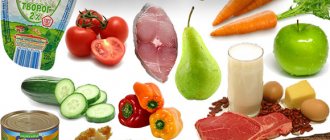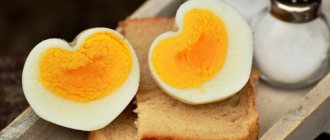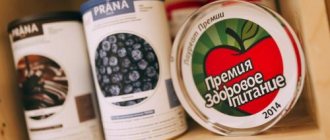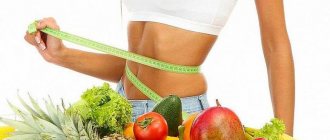About grain units
The name “bread unit” comes from the weight of a 25 gram slice of bread, which contains 12 grams of carbohydrates. Otherwise, 1XE = 12g. carbohydrates = 25g bread or ½ standard slice of regular loaf. This value was developed at the beginning of the 20th century in Germany. Today, there are some discrepancies in the quantitative composition of carbohydrates per 1 XE.
In the United States, one unit is equal to 15 grams, in Switzerland – to 10. The all-Russian XE is 12 g. The main purpose of bread (carbohydrate) units is the correct calculation of insulin doses relative to the amount of carbohydrates received by the body.
To avoid additional injections, it is necessary to control the amount of carbohydrates eaten. It is much more convenient to calculate XE. Twelve grams of carbohydrates increase glycemic levels by 2.5 mmol/l. To process 1 XE, a diabetic needs up to 2 doses of insulin units (IU).
During the day, the amount of insulin required per unit of bread may vary, depending on the general psychosomatic state, physical activity, individual response to insulin therapy, and the age category of the patient. The reference value for patients with type 1 diabetes is 24 bread units daily.
This value includes the sum of all carbohydrates consumed per day. Thus, the daily carbohydrate intake for diabetics should be within the range of 290–300 grams. Children's standards are slightly different:
| Age | from 4 to 6 years | from 7 to 10 years | from 11 to 14 years |
| Recommended amount of XE | 12–14 | 14–16 | 17–20 |
In case of non-insulin-dependent (insulin-resistant) type of disease, daily calculation of the qualitative and quantitative composition of carbohydrates can be used for weight loss. You just need to reduce the number of bread units, replacing some products with others.
According to the rules of the ninth diet, the diet includes six meals: three main, two additional and a light fermented milk drink an hour before going to bed. The distribution of XE norms for each meal should not be chaotic, but dividing them equally (4 units each) would be incorrect. According to the recommendations of nutritionists, in the first half of the day the carbohydrate load should be greater.
In the evening, as a rule, physical activity decreases, and the body requires less glucose, therefore, fewer carbohydrate units. Otherwise, unspent glucose is transformed into fats, which leads to a set of extra pounds. When planning the daily norm of XE, you need to focus on the following figures:
- morning meal - 5;
- lunch - 3;
- lunch - 6;
- afternoon snack - 3;
- evening meal - 5;
- at night - 2.
How to count XE correctly?
Perhaps we should consider sweets first, because they are the most insidious food. One tablespoon of granulated sugar contains 1XE.
It should be remembered that you should eat sweets only after the main meal. This way there will be no sudden spikes in insulin. In such a popular and beloved dessert by many as ice cream, one serving will contain 1.5-2 XE (if it is a 65-100g serving).
Although creamy ice cream contains more calories, it is better than fruit ice cream because... it contains more fat, which prevents carbohydrates from being absorbed too quickly. There are too many sugars in popsicles. In order to know how much XE is in sausages or bananas, you just need to use our table or download it for free using this link. (Word format)
Menu creation
Counting bread units greatly simplifies the formation of a daily diet. Nutritionists recommend developing a menu for the week so that the food is not only correct in terms of the amount of food, but also varied in terms of tasty and healthy dishes. Using a scale and a calculator, a diabetic needs to evaluate all foods planned for consumption in the next seven days.
The more carefully each ingredient is calculated individually and their combination in a dish, the stricter the control over glycemic levels will be. With an occasional snack outside the home, a diabetic patient will be able to accurately calculate how many bread units he should aim for, and what dish on the menu he can replace with this snack. With the help of simple calculations, the patient will learn to manage diabetes.
Product selection
When choosing products based on the characteristics of bread units, one should not forget about other important parameters: GI and calorie content. You must immediately exclude:
- sweet desserts, rich pastries, confectionery;
- candies, waffles and other sweets not made specifically for diabetics;
- fast food dishes;
- smoked lard, meat and fish;
- chips, popcorn, flavored crackers and snacks;
- mayonnaise-based fatty sauces;
- sweet soda, ready-made packaged juices and bottled tea from the store;
- fatty meats (duck, pork, goose);
- canned food, including: stewed meat, meat and sprat pates, pickled vegetables and mushrooms, fruits in their own juice, canned fish;
- cereals with a high glycemic index (sago, white rice, semolina).
Products with an average glycemic index are allowed on the menu on a limited basis:
- semi-finished products with minced meat (dumplings, khinkali);
- beets and potatoes;
- flour products (pasta, noodles, pancakes, pancakes);
- fruits banana, persimmon, mango, kiwi;
- melons and fruits: pumpkin, watermelon, melon.
The correct food basket for a diabetic includes:
- all vegetables, berries and fruits with a GI from 0 to 30 units;
- legumes (beans, chickpeas, peas, lentils);
- cereals: egg, wheat, oats, buckwheat, pearl barley;
- bread: rye, whole grain;
- durum pasta;
- dietary meat (rabbit, chicken, turkey);
- seafood and fish;
- mushrooms, nuts, eggs;
- dairy and fermented milk products (low fat content).
List of permitted and prohibited products
Diet guidelines for diabetics with different types of the disease vary. However, there are dishes that endocrinologists do not recommend eating.
The list of prohibited products includes:
- potatoes - fried, fries, chips;
- sweet fruits - grapes;
- fatty meats;
- smoked meats;
- canned food in oil;
- pates;
- sweet cheeses, curd mass;
- sweet yoghurts;
- margarine;
- white bread and pastries made from white flour;
- juices from the store;
- soda;
- alcohol;
- candies, chocolate;
- jam;
- condensed milk;
- fast food.
Patients will love the following foods and drinks:
- mineral water;
- rosehip compote;
- vegetable juices;
- freshly squeezed juices from sweet and sour berries and fruits;
- unsweetened citrus fruits;
- frozen and fresh berries;
- low-fat fermented milk products without sugar;
- dietary meat - chicken, turkey, veal, rabbit;
- cabbage;
- legumes;
- mushrooms;
- tomatoes;
- eggplant;
- greenery;
- asparagus;
- broccoli;
- milk;
- baked goods made from wholemeal flour;
- seafood;
- fish.
Live healthy! Superfood against diabetes. (03.12.2015)
To reduce the starch content in vegetables and cereals, it is recommended to soak them before cooking.
Results
Bread units for diabetes help to create a menu as accurately as possible. It is enough to know the formula for converting carbohydrates to protect yourself from eating food that can be harmful to your health.
Diet “by bread units” (XE) is a diet based on creating a menu according to the equivalence of certain dishes to bread units. One XE is equivalent to one 1.5 cm wide piece of loaf and 12 grams of carbohydrates.
The norm of bread units entering the body for a healthy person who does not follow any diets is 30 XE per day. For people who control their blood sugar levels and for those who want to lose excess weight, the value should be 10 XE.
According to this value, a special menu was compiled that excludes the following products from the diet:
- fast food and convenience foods;
- smoked meats;
- sugar, confectionery and baked goods;
- canned food;
- alcohol.
Diet No. 9
Back in the last century, Soviet nutritionist Mikhail Pevzner developed an effective nutritional method that ensures the normalization of carbohydrate and fat metabolism, and also allows us to identify the body’s sensitivity threshold to carbohydrates. Its well-known name is diet No. 9. The effectiveness of this low-carbohydrate diet is due to its balanced chemical composition and low energy value (within 1900–2400 kilocalories). It provides the patient with a complete amount of proteins (90 g), fats (80 g) and a reduced amount of carbohydrates (no more than 350 g). A diet for diabetes mellitus corrects weight in case of obesity and regulates water and electrolyte balance. The amount of salt consumed should not exceed 12 g, and the volume of liquid drunk should not be less than one and a half liters.
Diet No. 9 includes two subtypes: 9 A - suitable for nutrition in the second type of diabetes, for obesity, for patients not subject to insulin therapy and as a diet for diabetes in pregnant women; 9 B - is prescribed to patients with a severe stage of the disease and is adjusted to the characteristics of taking insulin medications (mainly for the first type of disease).
Diet menu table by bread units
| Breakfast | Dinner | Dinner | |
| First day | Apple and carrot salad with lemon juice, coffee without sugar | Vegetarian borscht, dried fruit compote | Boiled chicken breast, natural unsweetened yogurt |
| Second day | White cabbage salad with olive oil, coffee with milk | Broccoli soup, apple compote | Grilled fish, 200 ml low-fat kefir |
| The third day | 2 apples, dried apricots, green tea | Vegetable soup, dried fruit compote | Boiled beef (150 gr.), a glass of curdled milk |
| Fourth day | 2 apples, raisins, coffee without sugar | Vegetarian borscht, dried fruit compote | Boiled brown rice with soy sauce, a glass of kefir (low-fat) |
| Fifth day | Apple, orange, green tea | Sauerkraut cabbage soup, plum compote | Boiled buckwheat with soy sauce, a glass of fermented baked milk |
| Sixth day | Carrot and apple salad with lemon juice, coffee | Sauerkraut cabbage soup, sauerkraut compote | Pasta with tomato sauce (200 gr.), a glass of curdled milk |
| Seventh day | Apple, banana, green tea | Borscht without meat, dried fruit compote | Grilled chicken fillet (200 gr.) glass of kefir |
After seven days, this menu is repeated. The duration of the bread unit diet to achieve a good result is at least two weeks. The first week is accompanied by fluid loss, and during the second, the body gets used to the new diet and just begins to break down its own fat.
When following this diet, you should take into account the lack of raw vegetables in the diet, which are a source of fiber. Contraindications for the diet are gastrointestinal and kidney diseases. Pregnant women, children and teenagers should not use this diet either.
If you find an error, please select a piece of text and press Ctrl+Enter.
Insidious ice cream
Read more…
This delicacy has its own characteristics. Firstly, you should never use ice cream to relieve an attack of hypoglycemia; secondly, do not replace an afternoon snack or a snack before bed with a portion of ice cream - you can get the same hypoglycemia an hour later.
Why is this happening? The fact is that although ice cream clearly contains sucrose, it is fatty and very cold, and these two circumstances significantly slow down the absorption of sugar. As a result, ice cream is classified as a " slow sugar " product; it can be eaten in quantities of 50-70 grams throughout the day or for dessert. Ice cream must be converted into bread units according to the norm: 65 g = 1 XE .
Remember!
There is no need to combine ice cream with hot food or hot drink, as its “cold properties” will be weakened.
Advantages and disadvantages
In order for a diet to help achieve the desired results without harm to health, it is worth assessing its positive and negative aspects in advance.
Advantages:
- promotes weight loss even if you are obese;
- allowed for atherosclerosis, diabetes;
- removes free radicals, toxins, heavy metal salts, waste, excess liquid;
- hunger is not felt at all;
- compatibility with physical activity;
- budget;
- unlimited terms;
- weight does not return (with proper exit);
- slight and gradual weight loss leads to the absence of sagging skin, stretch marks, and depletion of muscle mass;
- the craving for sweets is dulled.
Flaws:
- the lack of proteins can still negatively affect muscle mass;
- lack of fat can worsen metabolism;
- deficiency of calcium and vitamins.
To ensure that the results do not disappoint you, take into account all the disadvantages and try to somehow eliminate them, following the recommendations of experts.
Effect on the body
It is well known that the main enemy of a beautiful figure is carbohydrates. It is on this statement that most nutritional systems that promote weight loss are based: they advocate either complete or partial rejection of high-calorie foods.
Olga Raz was able to experimentally prove the opposite. Her main discovery was the fact that low-carb diets reduce serotonin levels in the body. This is the same hormone of happiness. It is not difficult to guess what happens to a person when he loses this little wizard. The mood deteriorates sharply, the appetite grows, and the feeling of hunger eventually becomes almost uncontrollable.
The bread diet avoids these side effects. It provides the body with the necessary amount of carbohydrates, and meanwhile, weight loss will occur by limiting other foods and portion sizes.
The basis is low-calorie bread, which is made from whole flour (bran, rye) or bread. It contains a lot of vitamins (E, B1, B2), minerals (magnesium, phosphorus, calcium, potassium, etc.). The maximum number of calories consumed is limited to 35-45.
The actual mechanism for losing weight is extremely simple: bread rich in coarse fibers does not provoke a sharp release of glucose and insulin. Energy is produced by the body more slowly and is consumed gradually. As a result, no fat deposits are formed in problem areas.
A bread fast can last quite a long time, as it does not limit physical activity and does not reduce performance. But usually it lasts for a week. And don’t expect stunning results: they will be minimal (4 kg), but lasting.
Dairy
Milk and dairy products are a source of calcium and animal protein. In small quantities they contain almost all vitamins, and most of all vitamins of group A and B2. When dieting, it is recommended to give preference to milk and low-fat dairy products.
| Product | Quantity of product per 1 XE | |
| milk | 1 glass | 200 ml |
| baked milk | 1 glass | 200 ml |
| kefir | 1 glass | 250 ml |
| cream | 1 glass | 200 ml |
| yogurt (natural) | 200 g | |
| Ryazhenka | 1 glass | 200 ml |
| milk ice cream (without glaze and waffles) | — | 65 g |
| creamy ice cream (in glaze and wafers) | — | 50 g |
| cheesecake (medium, with sugar) | 1 piece | 75 g |
| curd mass (sweet, without glaze and raisins) | — | 100 g |
| curd mass with raisins (sweet) | — | 35-40 g |











